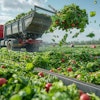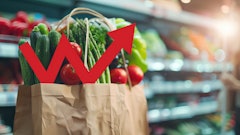
Yogurt is a great proxy for studying packaging with several constraints. It must stay fresh, so it's got a cold chain constraint. Unlike many dried foods or other products, it needs impermeable barriers. It has a much higher level of packaging associated with it than a bag of potato chips. And, as a product, consumers are constantly searching for the right variety of yogurt, creating a high churn and exploration rate, which leads to a lot of waste, including the packaging and the yogurt itself. Additionally, it's quite popular with families, a group that is often interested in sustainability.
U.S. and the EU: Divided by what to do with half-empty yogurt containers
Results from EPAM Continuum’s recent research study showed the difference between American and European attitudes toward recycling and refilling a yogurt container. Americans thought it was a ghastly and antiquated idea that would never work because of the logistics involved. Europeans, on the other hand, were shocked that Americans weren't already re-using their containers. After all, it works so well in their countries. It essentially came down to different disposal and fulfillment models.
Part of the issue is European legislation requiring recycling, so businesses have stepped up their offerings to reflect it. Another element to consider is population density, as an empty European bottle is not moving nearly as far to get refilled as an American one might.
The marriage of different data types
Another important revelation of the survey was the separation between the respondents' attitudes and their actual behavior toward sustainability. Consider that while someone may say one thing about sustainability, they might act another way. For example, in a qualitative setting, if you ask someone, "Is sustainability important to you?" they say, almost without a doubt, "Yes. Absolutely. It's the most important thing; what else are we here for?"
However, when those surveyed were forced to rank sustainability alongside a set of considerations—price, flavor, packaging type, location, brand, weight—it quickly lost its luster. Although no one wanted to say it wasn't the least important thing, the results revealed that sustainability was second to the bottom. The true feelings of the respondents became evident after the quantitative data and the qualitative research got merged. (The least important was expiration date.)
The study's findings also discovered that people only reflect upon the environmental footprint of their yogurt when they have to get rid of the container. And, for 46% of those surveyed, the first and second choice for the preferred method of container disposal is to recycle. Basically, people favor what they are already familiar with, and they are willing to try something new as long as it fits in with their current habits and lifestyle.
Researchers then wondered, will there be a change in people's attitude toward sustainable packaging that goes along with the change in their behavior, or do they have a fixed mindset?
The answer resides in the value proposition of the yogurt product itself.
Will we still be sustainable after the pandemic?
Researchers uncovered three core areas that resonate with yogurt-eaters. To get them to change behavior, you don't need to convince them that sustainability is important - instead, you have to tie it to the other things in their life that are important.
The first area is making the yogurt tasty. It has to be something that people want to eat. Much of the carbon footprint of yogurt is in the yogurt, not in the package. The degree that you can mitigate spoilage and reduced product waste is vital. You're actually going to get closer to your sustainability goals just by having good-tasting yogurt.
The second area centered around cleanliness. Yogurt's kind of gross to eat and even grosser to clean out the container. If a company can make a product format and a packaging type that is easy to clean and doesn't create more mess, it's critical to make that relevant to people. When it comes to cleanliness and recyclability, consider that dirty packaging is nonrecycled. The dirty yogurt that you're throwing in the recycling is not only not getting recycled, but it's also probably contaminating the entire batch when reused.
The third area of the process must be "mindless." The yogurt experience cannot require any new, additional behaviors. Researchers asked people if they were interested in eating it, burning it or taking it apart into its disparate pieces and sorting it in the right way, and they did not want to do that. What’s more, 20% of people would be open to eating the package itself, and 20% would be willing to repurpose it. Nevertheless, the majority just wanted to eat it or simply toss it in the bin. Life is busy enough without carving out extra time for your yogurt container. The more you can make the entire yogurt experience easy—not only purchasing but eating and disposing of it— you're more likely to have people follow through on the necessary steps.
It's on the designers of that product and the service and the experience around it to figure out how to take that simple, mindless behavior and make that sustainable. Choosing your doctor, applying to graduate school—are mindful things. This is yogurt. It needs to be as simple as possible.
Yogurt three ways
To highlight and demonstrate how these three value propositions can come to life in a new form of yogurt -- yogurt three ways got imagined. One experience around refillable; an experience around solid, no-mess yogurt; and an experience around dry, no-spoil yogurt.
The idea of refillable yogurt seems obvious– multiple-use containers and an easy way to turn them back in. The Europeans have already proven this works, but you're probably asking yourself solid yogurt? And dry yogurt?
For solid, imagine a granola-bar-meets-yogurt and what that might look like if we increase the density of yogurt so you can take it on the road and in ways that the fresh stuff can't go right now. Combined with a fully compostable package, we imagine this format will have nearly zero solid waste.
For dry, think about dry, shelf-stable yogurt. A yogurt that comes pelletized and will never spoil, so you'll always have that dollop of yogurt sitting in the back of your shelf when needed for a recipe or a quick snack.
Although sustainability was the second to last issue for consumers, 79% of people indicated that they want low- to zero-waste packaged foods. Getting buyers to act on their emotions will be challenging, but at least, the desire already exists amongst yogurt eaters to become more sustainable. But now, with yogurt innovation never so tasty or so portable, consumers' feelings may soon match their choices.




















